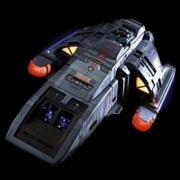Danube Class Runabout

This vehicle was designed to accomplish four main missions; the ability to perform rapid response scientific expedition transportation, the ability to act as an orbital or landed temporary operations base for science missions, the ability to transport intact experiment and cargo modules, and the ability to perform tactical missions such as intelligence gathering, covert insertion/extraction of personnel, and disruption of threat activities where feasible.
| type: | general purpose interstellar craft |
| crew: | 1 - 4 crew. 40 person evacuation limit for short duration flights |
| dimensions: |
|
| mass: | 158.7 metric tons |
| warp speeds: |
|
| armament: |
|
| defense systems: |
|
The Danube features a front cabin for the crew of pilot, co-pilot/navigator and two mission specialists. A two person transporter is at the rear of the cabin, with swappable mission modules aft of this. The modular nature of the Danube allows it to be configured for missions such as personnel transport, cargo transport, scientific research, tactical, medical, etc. Above the main spaces is the warp core, which is fed by an antimatter fuel pod at the aft and its matter equivalent at the fore end. The power transfer conduits run down the bulky nacelle roots, which also contain the impulse drive reactors and various other equipment.
The impulse engines comprise two sets of four fusion reactors, plus space-time drive coils and vectored exhaust directors. The system also includes interstellar or atmospheric intake vents and condenser-separators for fuel distillation. Control and fuel feed connections are essentially identical to any comparable impulse system. When maintenance is required, the entire assembly can be removed as a single unit.
The vehicles twin computer core is located under the cockpit sub floor and measures 2.3 x 2.1 x 1.3 meters. It is a standard isolinear unit, with a total of 186 isolinear banks and 53 command pre-processors and data analysis units. Sub nodes distributed throughout the vehicle report to the main computer via a standard ODN system.
The Danube's tactical systems are surprisingly comprehensive for a vehicle of its size. The micro torpedo launchers fire 14 cm torpedoes which can carry a variety of different loads, including photon or quantum warheads, chemical explosives, gases or biological agents. If required the Danube can also carry four full size torpedoes, while the six phaser arrays located on the cockpit, nacelles and rear compartment provide another weapon option. As on a starship, the shield system is fed by a portion of the warp power output.
Relatively few Starfleet shuttlecraft are capable of undertaking true interstellar journeys, and those that are tend to be the larger classes. Although Starfleet has occasionally requested the resources to correct this situation, such projects have never been a high priority and have tended to be cancelled in their early stages. It was 2368 before Starfleet finally decided to really push for a new design to correct this deficiency; in this year a request was made for a new type of shuttle capable of carrying one or two people across distances of several light years in relative comfort, or of carrying up to four persons on shorter duration missions. The speed requested was much higher than most previous vessels, in line with the general trend towards much faster vessels, which has been a recent feature of all Starfleet designs after recent advances in warp propulsion technology.
The design process was implemented late in 2368 and was almost completed by early next year when Starfleet halted the program and reassessed its requirement. It was decided that several new features should be included in the craft; these included an increase from one to two micro torpedo launchers, a more capable onboard computer system, and a beefing up of the armament by the addition of two Phaser arrays to the single emitter, which had been the only beam weapon.